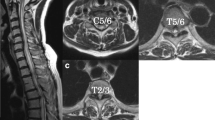Summary
A case of communicating syringomyelia is presented with a history of sudden onset following a minor fall. It is suggested that a sudden venous pressure change may have been responsible for the onset of symptoms. Operative findings in this case and observation of other cases together with perusal of the literature leads us to the conclusion that the gradual progression of symptoms in all reported cases of communicating syringomyelia could well be explained by the effects of venous distension within the spinal canal and cranium leading to diversion of fluid into a communication. In all cases it seems that there is a narrowing or obliteration of the normal passage which cerebrospinal fluid would usually take in the subarachnoid space as it ebbs and flows along the outside of the medulla and cervical cord.
Similar content being viewed by others
References
Appleby, A., J. B. Foster, J. Hankinson, andP. Hudgson, The diagnosis and management of the Chiari abnormalities in adult life. Brain91 (1968), 131–140.
Burnett, H. J. M., E. H. Botterell, A. T. Jousse, andM. Wynne-Jones, Progressive myelopathy as a sequal to traumatic paraplegia. Brain89 (1966), 159–174.
Conway, L. W., Hydrodynamic studies in syringomyelia. J. Neurosurg.27 (1967), 501–514.
Cossa, M. P., Syringomyélie secondaire à une blessure de la moelle dorsale supérieure. Revue neurol.75 (1943), 39–40.
Finkle, J. R., Lesions ascending from spinal cord injuries. Prox. 9th Ann. Clinical Spinal Injuries Comp. (1960), p. 45.
Ford, F. R., Disease of the nervous system in infancy, childhood and adolescence, 3rd ed. (1952), p. 920–926.
Foster, J. B., P. Hudgson, andG. W. Pearce, The association of syringomyelia and congenital cervico-medullary anomalies: pathological evidence. Brain92 (1969), 25–34.
Freeman, L. W., Ascending spinal paralysis. J. Neurosurg.16 (1959), 120 to 122.
Gardner, W. J., A. F. Abullah, andL. J. McCormack, The varying expressions of embryonal atresia of the fourth ventricle in adults. J. Neurosurg.14 (1957), 591–607.
—, Hydrodynamic mechanisms of syringomyelia: its relationship to myelocoele. J. Neurol. Neurosurg. Psychiat.28 (1965), 247–259.
— andJ. Angel, The mechanism of syringomyelia and its surgical correction. Clin. Neurosurg.6 (1959), 131–140.
Hankinson, J., in: Modern Trends in Neurology. London: Butterworth. 1970.
Holmes, G., The Goulstonian lectures on spinal injuries of warfare. 1. The pathology of acute spinal injuries. Brit. Med. J.2 (1915), 769.
Jung, E., Syringomyelia in Kombination mit Entwicklungstoren der Nieren und mit schwerer Wirbelsäulenverletzung. Med. Klin.55 (1960), 1678.
Kellie, G., An account of the appearances observed in the dissection of two of three individuals presumed to have perished in the storm of the 3 d, and whose bodies were discovered in the vicinity of Leith on the morning of the 4th November 1821 with some reflections on the pathology of the brain. Trans. Med. Chir. Soc. Edinburgh1 (1824), 84–169.
Lichtenstein, B. W., Neuropathology. Philadelphia: Saunders. 1949.
Logue, V., Syringomyelia: a radiodiagnostic and radiotherapeutic saga. J. Clin. Radiol.22 (1971), 2–16.
Martin, C., etM. Maury, Syndrome syringomyélique après paraplegia traumatique. La Presse Médicale72 (1964), 2839–2842.
Monro, A., Structure and function of the nervous system. Edinburgh: Creech. 1783.
Newton, E.J., Syringomyelia as a manifestation of defective fourth ventricular drainage. Ann. Roy. Coll. Surg. Eng.44 (1969), 194–213.
Nurick, S., J. A. Russell, andM. J. F. Deck, Cystic degeneration of the spinal cord following spinal cord injury. Brain93 (1970), 211–222.
Rossier, A. B., A. Werner, E. Wilki, andJ. Berney, Contribution to the study of late cervical syringomyelic syndrous after dorsal or lumbar traumatic paraplegia. J. Neurol. Neurosurg. Psychiat.31 (1968), 99.
Weed, L. H., Positional adjustments of the pressure of the cerebrospinal fluid. Physiol. Rev.13 (1933), 80–102.
Williams, B. N., The distending force in the production of “Communicating Syringomyelia”. Lancet2 (1969), 189–193.
Williams, B., Unpublished observations. 1971.
—, The distending force in communicating syringomyelia (letter). Lancet2 (1970), 41–42.
Wilson, S. A. K., Neurology, 2nd Edition. London: A. N. Bruce. 1954.
Zdrojewski, B., A. Werner etA. Rossier, Syndrome syringomyélique cervical tardif après paraplégie traumatique dorsale. Neurochirurgie15 (1969), 153–164.
Zeilaskowski, M., Beitrag zur Frage der Entwicklung syringomyelitischer Prozesse auf dem Boden traumatisch bedingter Herde im Rückenmark. Berliner Klin. Wschr.1 (1923), 354–355.
Author information
Authors and Affiliations
Rights and permissions
About this article
Cite this article
Williams, B., Turner, E. Communicating syringomyelia presenting immediately after trauma. Acta neurochir 24, 97–106 (1971). https://doi.org/10.1007/BF01403315
Issue Date:
DOI: https://doi.org/10.1007/BF01403315




